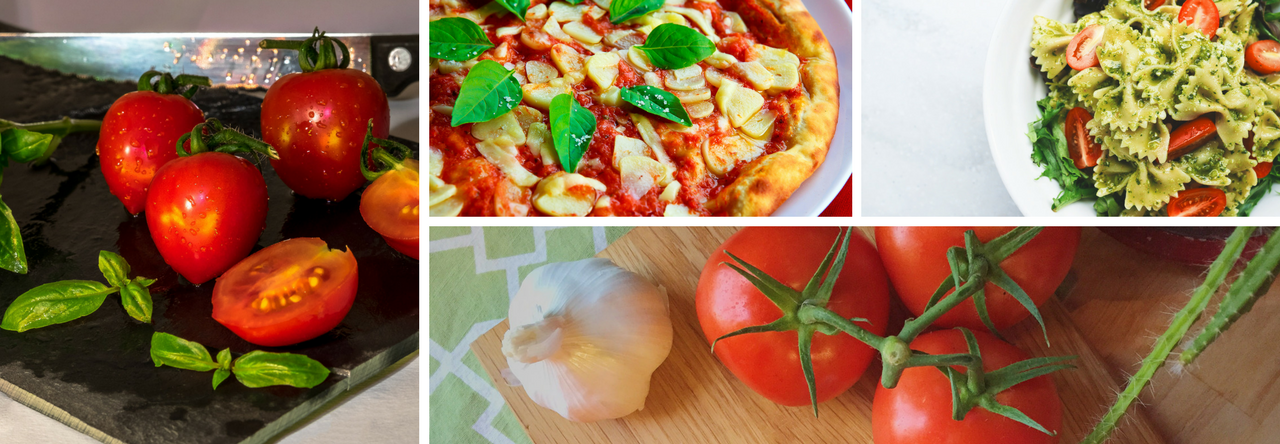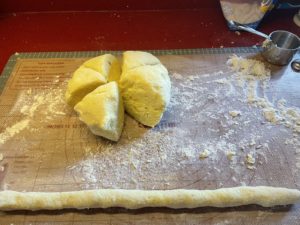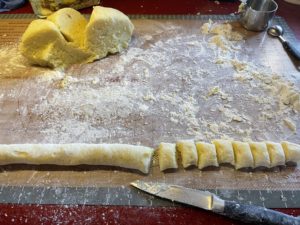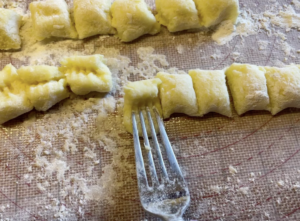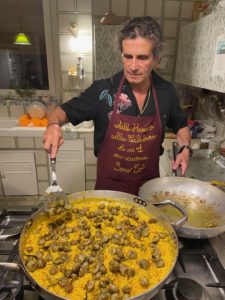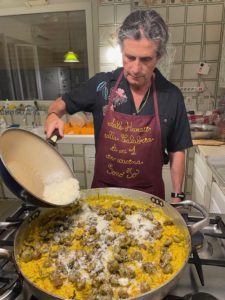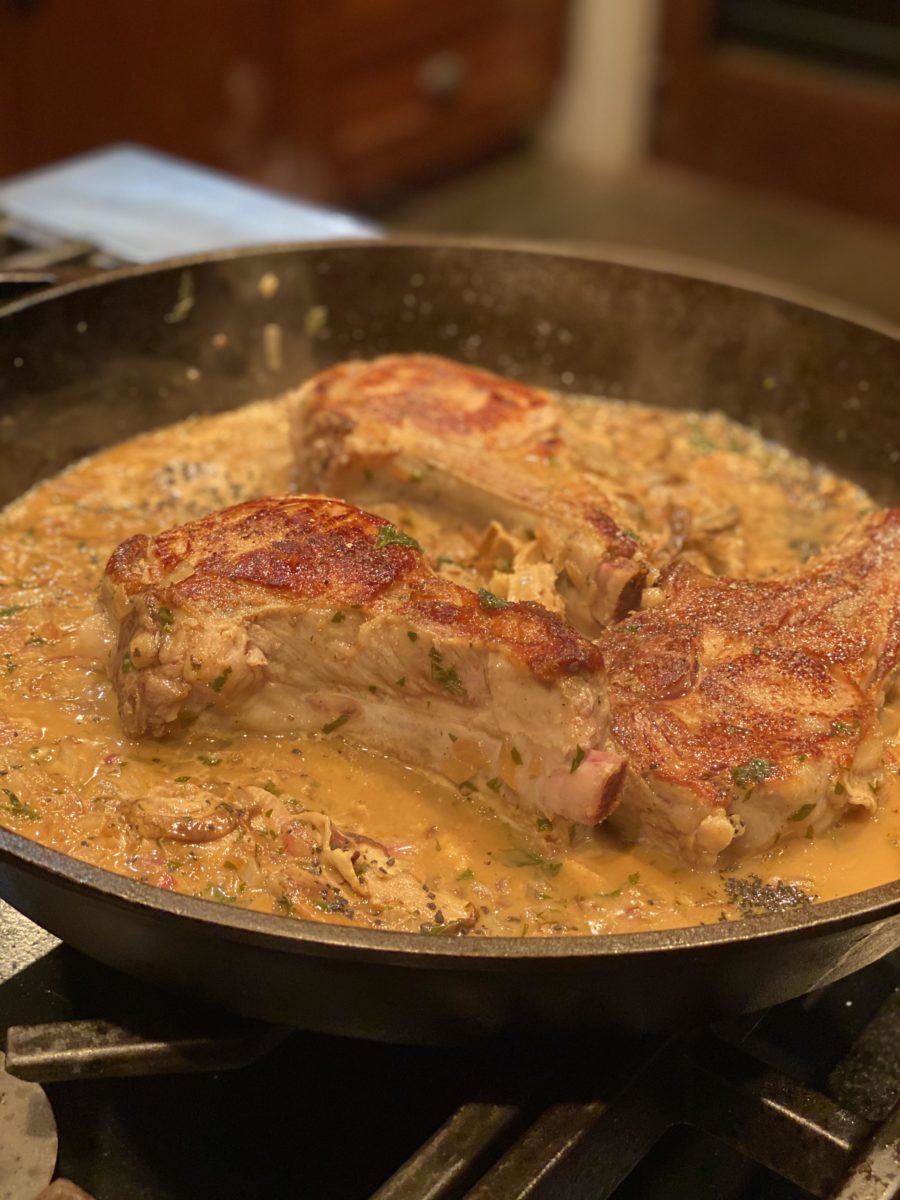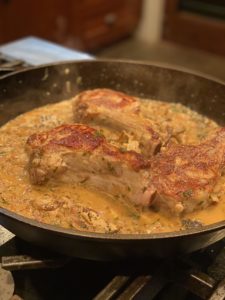Roasted Rabbit
One day a few years ago, my wife Betti called me from Whole Foods. “They have frozen rabbit,” she said. “Didn’t you tell me that you wanted to cook something different?” I told her to buy it, and then began looking through my cookbooks for a good recipe.
After going through several of my favorite books, including the one my mother gave me in college (Il Cuoco Gentiloumo), I decided that none of them were quite right. I decided to create my own recipe, and it turned out to be one of my best.
Ingredients
- 1 rabbit cut in 8-12 pieces (ask the butcher to do it if you do not know how)
- Extra virgin Italian olive oil
- 1 green bell pepper, sliced into in 8 wedges
- 1 large ripe tomato, Heirloom preferred, sliced into 8 wedges
- 2 teaspoons of capers
- 2 tablespoons of good-quality green olives (pitted)
- 5 cloves garlic
- 1 bunch of Italian parsley
- 4 bay leaves
- 1 bunch of basil
- 2 sprigs of fresh rosemary, just the leaves
- ¾ of a cup white wine
- Juice from 3 lemons
- Balsamic vinegar, ¼ of a cup
- ½ cup all-purpose flour
- 1 hot spicy pepper
Preparation
- Marinate the rabbit with:
- 1/3 of cup olive oil
- 3 cloves of garlic, smashed
- The juice of 3 lemons
- 2 sprigs of rosemary –needles only
- 8-10 basil leaves
- The green bell pepper in 8 pieces
- Salt and black pepperTurn the pieces over every 20 minutes or so, for about 1 hour.
- Start oven convection roast 475 – 480 F
- In a roasting pan, or Dutch oven (for example, Staubb or Le Crueset), add 1/4 cup of olive oil, 1 minced red pepper (for example, a Calabrian red pepper or a Thai pepper), 2 cloves of smashed garlic, some coarse salt. Add the rabbit pieces and half of the marinade.
- Cook for 10 minutes on high, mixing every so often to brown the rabbit.
- After 10 minutes, add the rest of the marinade and continue to brown for 5 more minutes.
- In the meantime, get a medium sized bowl and mix together ¾ of a cup of white wine, ¼ of cup of balsamic vinegar. Add half of the remaining minced parsley.
- Remove the pan from the fire, and add ½ cup of flour, the wine and balsamic vinegar mix, and 1 cup of water to the pan. Mix the liquid well and then add the slices of tomato and the rest of the parsley. Put the pan into the oven and lower the heat to 400 F.
- After 15 minutes, add the 2 teaspoons of capers and the 2 tablespoons of green olives. Cook for 5 more minutes.The total roasting time is 20 minutes, or 25 minutes if you cook a large rabbit or double this recipe.
- Remove from the oven, sprinkle with the remainder of the minced parsley, a handful of fresh basil and serve with excellent, crusty bread.
- Buon Appetito!
Italiano: Coniglio di Miguel
Ricetta che ho inventato perché tutte quelle che trovavo non mi piacevano. È venuto il miglior coniglio che ho mai mangiato e da allora è uno dei miei piatti preferiti.
Ingredienti
- 1 coniglio intero tagliato in 8-12 pezzi. Se non sapete tagliarlo chiedete al macellaio di farlo per voi
- Olio extravergine di oliva italiano
- 1 peperone verde, tagliato in 8 spicchi
- 1 pomodoro grande maturo, preferito Heirloom, tagliato in 8 spicchi
- 2 cucchiaini di capperi
- 2 cucchiai di olive verdi di buona qualità (denocciolate)
- 5 spicchi d’aglio
- 1 mazzetto di prezzemolo italiano
- 4 foglie di alloro
- 1 mazzetto di basilico
- 2 rametti di rosmarino fresco, solo le foglie
- ¾ di bicchiere di vino bianco
- Succo di 3 limoni
- Aceto balsamico, ¼ di tazza
- ½ tazza di farina per tutti gli usi
- 1 peperoncino piccante
Preparazione
- Mettere il coniglio a marinare per circa 1 ora in una pentola con: 3 limoni spremuti, 3 spicchi d’aglio schiacciati, ½ tazzina di caffè di olio d’oliva, 1 peperone verde tagliato in 8 pezzi, 4 foglie di lauro, 1 rametto di rosmarino (solo gli aghi), un pugno di basilico, sale e pepe nero. Girare ogni 20 minuti circa.
- Accendere forno a 250C.
- In una buona pentola di alluminio o di ferro, 1/3 di tazzina di caffè d’olio d’oliva, 1 peperoncino piccante, quelli calabresi sono i migliori, 2 spicchi d’aglio schiacciati, un po’ di sale grosso. Aggiungere il coniglio e mezza marinata, fuoco forte fate rosolare per 10 minuti.
- Passati 10 minuti, aggiungete il resto della marinata e continuate a rosolare per 5 minuti a fuoco forte.
- Preparate 1 bicchiere 3/4 di vino bianco 1/4 di aceto balsamico e tagliate in 4 pezzi un grosso pomodoro. Tritate 1/2 mazzetto di prezzemolo. Prendete la farina.
- Spegnete il fuoco, aggiungete due pugni di farina, il bicchiere vino e aceto, e lo stesso volume di acqua, rimestando per sciogliere la farina, aggiungete metà del prezzemolo e il pomodoro a pezzi, infornate scoperto abbassando il forno a 200.
- Dopo 15 minuti aggiungere 2 cucchiai di capperi e due di olive verdi (buone non olive in barattolo.) Infornate per altri 5 minuti (tempo totale in forno 20 minuti che diventane 25 se il coniglio è grosso o se state cuocendo due conigli).
- Togliere dal forno spruzzarci sopra un po di prezzemolo, e basilico fresco e buon appetito!

